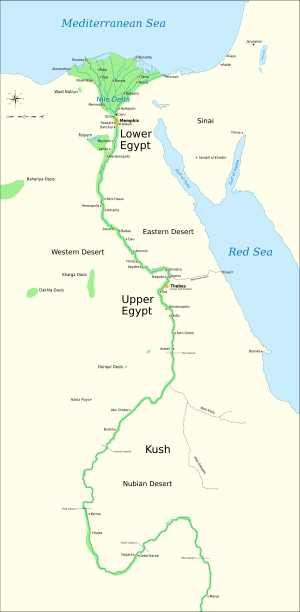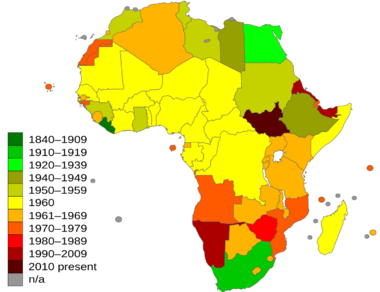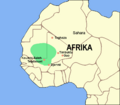History of Africa facts for kids
Africa is a huge continent with a very long and exciting history! Modern humans, called Homo sapiens, first appeared in East Africa about 300,000 to 250,000 years ago. Over time, people spread across the continent and beyond. Ancient Egypt, one of the world's first great civilizations, started writing history around 4,000 years ago. Other important early kingdoms included Kush in Nubia and Carthage in North Africa. Many African societies also kept their history alive through amazing oral traditions, passed down from generation to generation.
Africa was home to countless kingdoms and empires. Some grew through conquest, while others developed by sharing ideas or through their own growth. Powerful empires like Ghana, Mali, and Songhai ruled in West Africa. In North Africa, Ancient Egypt, Kush, and Carthage were very important. Aksum and Ethiopia were strong in East Africa, and Kongo and Luba were major powers in Central Africa. In Southern Africa, kingdoms like Mapungubwe and Zimbabwe thrived. These empires often became very strong in their regions.
Starting in the 600s AD, Islam began to spread across North Africa and the Horn of Africa from Arabia. It later moved south into other parts of the continent, often helped by trade. Sadly, systems of servitude and slavery were common in parts of Africa, just like in many other ancient and medieval societies around the world. When slave trades across the Sahara, Red Sea, Indian Ocean, and Atlantic began, some local systems started supplying captives for markets outside Africa. The Atlantic slave trade, between 1450 and 1900, was the largest of these, moving over 12 million enslaved people overseas.
From 1870 to 1914, European countries rapidly took control of almost all of Africa. This period is known as the "Scramble for Africa." Major European powers divided the continent among themselves at the Berlin Conference in 1884. European rule changed African societies a lot and often stopped local traditions. Christianity, which had a long history in parts of North and East Africa, spread widely in other areas during this time.
After World War II, many African countries fought for and gained their independence. This led to a big wave of decolonization across the continent, especially in 1960, known as the "Year of Africa." African countries decided to keep their colonial borders to avoid new conflicts. Today, many traditional power structures still exist in Africa, playing different roles in different countries.
Contents
- Ancient History of Africa
- Medieval and Early Modern Africa (600s – 1870s)
- Colonial Period (1870–1951)
- Postcolonial Africa (1951 – Present)
- How We Study African History Today
- See also
- Images for kids
Ancient History of Africa
Early Humans in Africa
The very first human-like creatures, called hominids, developed in Africa. Their skulls looked a bit like gorillas and chimpanzees, which also evolved in Africa. But hominids walked on two legs, which was a big advantage. This helped them live in both forests and open grasslands as Africa's climate changed.
The oldest known fossils of Homo sapiens (modern humans) are from Africa, dating back about 350,000 to 260,000 years ago. Scientists think modern humans might have appeared by different groups of people mixing in East and South Africa.
Early Homo sapiens in Africa showed many signs of modern behavior. They made abstract art, found new ways to get food, and created tools. For example, at Blombos Cave in South Africa, scientists found rectangular pieces of colored rock with geometric designs, dating back 77,000 to 100,000 years ago. Engraved ostrich eggshells were found at Diepkloof, South Africa, from 60,000 years ago. Beads and other personal decorations, some as old as 130,000 years, have been found in Morocco and South Africa.
Around 65,000 to 50,000 years ago, modern humans began to spread out of Africa, eventually settling all over the world. Scientists can track these movements using language, culture, and genetic evidence.
Early Farming and Metalworking
Around 16,000 BC, people in the Red Sea Hills and Ethiopian Highlands started gathering nuts, grasses, and tubers for food. By 13,000 to 11,000 BC, they began collecting wild grains. This idea spread to Western Asia, where wheat and barley were first farmed. Between 10,000 and 8000 BC, people in Northeast Africa were growing wheat and barley and raising sheep and cattle from Southwest Asia.
In the Ethiopian Highlands, people domesticated a plant called enset around 6500–5500 BC. They also domesticated donkeys by 7000 BC, and these animals spread to Southwest Asia by 4000 BC. Other crops like teff and finger millet were domesticated between 5500 and 3500 BC.
Pottery was invented independently in Africa around 9,400 BC in central Mali. It quickly spread across the Sahara and Sahel regions. In Northern West Africa, people started collecting and farming wild millet, African rice, and sorghum between 8000 and 6000 BC. They also started raising wild cattle and building stone settlements.
The earliest evidence of melting metals like lead, copper, and bronze in Africa dates back to the fourth millennium BC. Egyptians melted copper during the predynastic period, and bronze was used after 3000 BC in Egypt and Nubia. Nubia became an important source of copper and gold.
In the Aïr Mountains of Niger, people melted copper independently between 3000 and 2500 BC, using a unique method. By the 1st millennium BC, iron working had reached Northwestern Africa, Egypt, and Nubia. Some researchers believe that people in sub-Saharan Africa invented iron metallurgy (the science of working with metals) on their own. Iron smelting has been dated to 2000 BC in southeast Nigeria and 3000 to 2500 BC in the Central African Republic and Cameroon.
Ancient North-East Africa and the Horn of Africa
Ancient Egypt and Nubia
The ancient history of North Africa is closely connected to the Middle East and Europe. This is especially true for the different cultures and dynasties of Ancient Egypt and Nubia. Around 3500 BC, different groups in Egypt joined together to form Upper and Lower Egypt. Egypt was first united around 3150 BC by King Narmer, starting the First Dynasty. This led to the powerful Old Kingdom, known for building the great pyramids.
At the same time, the Kingdom of Kerma grew in Nubia, controlling a large area south of Egypt. The Old Kingdom of Egypt eventually weakened, leading to a period of chaos. Later, the Middle Kingdom reunited Egypt and expanded into Nubia.
Around 1700 BC, Egypt split again. A group called the Hyksos from Palestine conquered Lower Egypt, while Kerma invaded Egypt from the south. Eventually, Ahmose I of Thebes drove out the Hyksos and formed the New Kingdom around 1550 BC. This was Egypt's golden age, as they conquered lands in the Middle East and Nubia.
The New Kingdom also collapsed around 1069 BC due to internal problems and invasions. This allowed the Kingdom of Kush in Nubia to become fully independent. In the 8th century BC, Kushite kings even conquered Egypt, forming the Kushite Empire. They adopted many Egyptian traditions and built pyramids. However, the Assyrians later drove them out of Egypt.
Egypt was then conquered by the Persians in 525 BC, and later by Alexander the Great in 332 BC. After Alexander, the Ptolemaic dynasty, a Greek family, ruled Egypt. They tried to blend in with Egyptian culture. But the kingdom weakened and was eventually conquered by the Roman Republic in 30 BC, becoming a Roman province. Kush, however, remained independent and a major power until it broke into smaller kingdoms around 5th century AD.
Horn of Africa's Ancient Kingdoms
In the Horn of Africa, the Land of Punt was an important kingdom on the Red Sea, probably in modern-day Eritrea or northern Somaliland. Ancient Egyptians traded with Punt for gold, resins, wood, ivory, and wild animals for over a thousand years.
Later, the Kingdom of D'mt appeared in northern Ethiopia and Eritrea around 980 BC. Its people developed irrigation, used plows, grew millet, and made iron tools. In modern-day Somalia and Djibouti, the Macrobian Kingdom existed.
After D'mt fell, smaller kingdoms ruled the Ethiopian Plateau. Then, the Kingdom of Aksum grew powerful in the 1st century BC. Aksum became a major trading power between Rome and India. They conquered neighboring lands and parts of the weakening Kingdom of Kush. In the 3rd century AD, a Persian prophet named Mani even called Aksum one of the four great powers of the world, along with Persia, Rome, and China.
In the 4th century AD, Aksum's king converted to Christianity, and the people slowly followed. Aksum continued to be a strong kingdom, even invading parts of South Arabia in the 6th century AD. However, by the late 6th century, they were driven out of Yemen by the Sassanids.
Ancient North-West Africa: Carthage and Beyond

In North-West Africa, the Maghreb and Ifriqiya regions were somewhat separate from Egypt. Phoenician traders from the Middle East set up settlements there, looking for metals. These settlements grew into the powerful city of Ancient Carthage after it became independent from Phoenicia in the 6th century BC.
Carthage built a large empire and a strong trading network that reached across the ancient world. They had one of the biggest and most powerful navies in the Mediterranean Sea. Carthage's government was well-organized, with a council of aristocrats providing stability.
In 264 BC, Carthage went to war with the expanding Roman Republic over the island of Sicily. This was the First Punic War, a huge naval war that Carthage eventually lost. The Second Punic War started when Rome took Sardinia and Corsica. The famous Carthaginian general Hannibal led his army, including elephants, across the Alps into Italy. He conquered much of Italy for 14 years. But Rome invaded Carthage's homeland, and Hannibal was defeated in 202 BC.
Carthage lost its fleet and much of its empire. Two new kingdoms, Numidia and Mauretania, emerged in the Maghreb. The Third Punic War in 146 BC led to Carthage's complete destruction by the Romans, who then created the province of Africa. Numidia and Mauretania were later also conquered by the Romans.
In the 5th century AD, the Vandals, a Germanic tribe, conquered North Africa, contributing to the fall of the Western Roman Empire. Many local Berber people regained their self-rule in kingdoms like the Mauro-Roman Kingdom. The Vandals ruled Ifriqiya for about a century until the Byzantine Empire reconquered it in the early 6th century AD.
Ancient West Africa

In the western Sahel region, settled communities grew because people started farming millet and sorghum. Archaeology shows large towns in West Africa from the 4th millennium BC. They developed iron metallurgy (working with iron) by 1200 BC, making tools and weapons.
Trade routes developed between the different regions, exchanging meats, copper, iron, salt, and gold. Many civilizations thrived during this time. The Tichitt culture in modern-day Mauritania and Mali, from 4000 BC, was the oldest known complex society in West Africa. Other important cultures included Kintampo in Ghana, Nok in Nigeria, and Djenné-Djenno in Mali. The Serer civilization in Senegal built the Senegambian stone circles.
Around the 3rd century AD, a wet period in the Sahel made more land livable. The Kingdom of Wagadu, also known as the Ghana Empire, grew out of the Tichitt culture. It became rich after camels were introduced, which made trans-Saharan trade much easier. Ghana controlled the trade of gold going north and salt going south.
Ghana's power came from its control over trade, which allowed it to unite many smaller groups into a confederated state. Large burial mounds across West Africa from this period suggest there were other powerful kingdoms that are now lost to history.
Ancient Central, Eastern, and Southern Africa
Sao Civilization and Bantu Expansion
In Central Africa, the Sao civilization thrived for over a thousand years, starting in the 6th century BC. The Sao lived near the Chari River, south of Lake Chad. They were skilled workers in bronze, copper, and iron, creating sculptures, pottery, and weapons.
The Bantu expansion was a huge series of migrations of Bantu-speaking peoples from Central Africa to Eastern and Southern Africa. Starting in the 2nd millennium BC, the Bantu began moving from Cameroon into the Congo Basin, setting up the foundations for future kingdoms like Kongo. They also moved eastward to the Great Lakes region, forming the Urewe culture, which led to empires like Kitara and later kingdoms like Buganda and Rwanda.
By the 7th century AD, Bantu people spread to the Upemba Depression, forming the Upemba culture, which would later lead to the Luba and Lunda empires. The Bantu continued moving south and east across Africa during the 1st millennium BC. They reached the upper Zambezi basin by the 2nd century BC and then pushed into Angola, Malawi, Zambia, and Zimbabwe in the 1st century AD, forming the Gokomere culture, which led to Mapungubwe and Zimbabwe.
Another group of Bantu speakers moved eastward from the Great Lakes in the 1st century AD, expanding into Kenya, Tanzania, and the Swahili coast.
Swahili Coast and Madagascar
Before the Bantu migration, the northern Swahili coast was home to Azania, likely a Southern Cushitic group. The Bantu populations eventually took over, and various city-states formed the Swahili civilization, trading across the Indian Ocean.
Madagascar was first settled by Austronesian people (from Southeast Asia) between 350 BC and 550 AD. These early settlers are called the Vazimba in Malagasy oral traditions.
By the 4th century AD, Bantu people who used iron and farmed were well established south of the Limpopo River, replacing the original Khoisan people. In Botswana, the San people, who are hunter-gatherers, are thought to be descendants of the first inhabitants of Southern Africa from 100,000 years ago, making them one of the oldest cultures on Earth.
Medieval and Early Modern Africa (600s – 1870s)
North Africa's Islamic Golden Age
The 7th century saw much of North Africa controlled by the Byzantine Empire. In 618, the Sassanids conquered Egypt, but the Byzantines quickly took it back.
The early 7th century also marked the beginning of Islam in Arabia. The new Muslim empire, the Rashidun Caliphate, expanded rapidly. They conquered Egypt by 642, as many Egyptian Copts were unhappy with Byzantine rule. The Muslims then moved west into the Maghreb.
The Muslims conquered Ifriqiya (modern-day Tunisia) in 647. The local Berbers initially agreed to pay tribute. After a brief civil war in the Muslim empire, the Umayyad dynasty took over in 661. They returned to the Maghreb, eventually defeating the Byzantines and local Berber kingdoms. By 701, they had conquered the rest of the Maghreb. Many Berbers converted to Islam, and combined Arab and Berber armies then expanded into Spain.
Many Berbers and Copts willingly converted to Islam. People of other Abrahamic religions (like Christians and Jews) were allowed to practice their faith if they paid a special tax. However, followers of traditional Berber religions were often forced to convert.
Later, many Berbers were unhappy with the Umayyad rulers. Different Islamic groups, like the Kharijites, found support among them. In the 740s, the Berber Revolt shook the caliphate, and the Berbers took control of the Maghreb.
The Abbasid dynasty came to power in 750. While they tried to make the empire more inclusive, it still began to break apart at its edges. Various local dynasties formed states, such as the Idrisids in Morocco and the Rustamids in Algeria. By the 9th century, the Abbasids' power weakened further, with the Aghlabids controlling Ifriqiya and the Tulunids ruling Egypt for a time.
Rise of New Dynasties
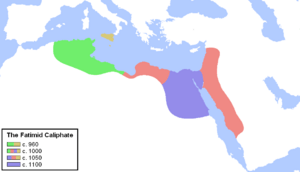
The Fatimid dynasty rose in 909, conquering the Aghlabids and taking control of Ifriqiya. They established their own caliphate, challenging the Sunni Abbasids. The Fatimids quickly conquered the Rustamid Imamate and fought against the Umayyad dynasty in Spain. They moved their capital to Cairo in 969 after conquering Egypt.
The Fatimids became more focused on their eastern lands. In 972, their vassals, the Zirids in Ifriqiya, switched their loyalty to the Abbasids. In revenge, the Fatimids sent nomadic Arab tribes to invade Ifriqiya, causing the Zirids to break apart.
In the 11th century, the Saharan Sanhaja, driven by a strict form of Sunni Islam, conquered Sijilmasa and Aoudaghost to control the rich trans-Saharan trade routes. They formed the Almoravid empire. The Almoravids then conquered parts of Morocco and intervened in Spain to help the Muslim rulers there against the Christian kingdoms.
To the east, the Fatimid empire began to collapse in 1061. The Seljuk Turks, who supported the Abbasid Caliphate, conquered many of their eastern territories. During the First Crusade, the Fatimids briefly took Jerusalem but then lost it. Their authority crumbled due to internal conflicts and Christian invasions of Egypt.
Ayyubids and Mamluks
Salah ad-Din Yusuf ibn Ayyub, known as Saladin, became a powerful general. After repelling Christian invasions, Saladin eventually overthrew the Fatimid caliph in 1171 and established the Ayyubid dynasty. They recognized the Abbasid Caliphate. The Ayyubids then expanded their empire, conquering parts of Arabia, Palestine, and Syria.
To the west, a new religious movement led by Ibn Tumart challenged the Almoravids. This movement, called the Almohads, gained support and swept through the Maghreb. They conquered the Hammadids and the Norman Kingdom of Africa, eventually taking over the Almoravid empire in Spain and North Africa by the 13th century.
However, the Almohads also faced internal conflicts. Christian kingdoms in Spain took advantage of this and conquered much of Spain by 1228. The Almohads gradually lost territory to new dynasties like the Marinids in Morocco, the Zayyanids in Algeria, and the Hafsids in Tunisia, finally falling in 1269.
Meanwhile, after defeating the Christians' Seventh Crusade in 1221, the Ayyubid dynasty faced internal divisions. In 1248, the Mamluks, who were military slaves, helped the Ayyubids defeat another Christian crusade. The Mamluks then revolted, killed the Ayyubid sultan, and took power in Egypt, establishing the Mamluk Sultanate.
The Mamluks re-established the Abbasid Caliphate in Cairo in 1261. Over the next few decades, they conquered the Crusader states and defeated the Mongols, consolidating their rule over the Middle East. To the west, the Marinids, Zayyanids, and Hafsids fought for control of the trans-Saharan trade. The Marinids briefly dominated but then weakened due to plague and financial problems. The Hafsids became the main power.
In the 15th century, the Spanish began colonizing the Canary Islands, leading to the destruction of the native Berber population. By the turn of the 16th century, the Mamluks faced challenges from the growing Ottoman Empire and Portuguese trade in the Indian Ocean.
East Africa: Swahili Coast and Madagascar
The Swahili coast continued to be home to the Swahili civilization, whose economies were based on farming and trade. They traded across the Indian Ocean and developed local industries and stone architecture. The Swahili civilization connected the kingdoms of the interior, like those in the Zambezi basin and the Great Lakes, to the wider Indian Ocean trade.
Madagascar was further settled by Austronesian peoples from the 5th or 7th centuries AD, who arrived by outrigger boats. This second wave likely found the island sparsely populated by descendants of the first settlers.
Trade expanded greatly from the 7th century as the Swahili people engaged in the flourishing Indian Ocean trade after the early Muslim conquests. Settlements grew, and major states included Gedi, Kilwa, Mombasa, and Malindi. They exported gold, iron, copper, ivory, and slaves, and imported silk, glassware, and Chinese porcelain.
Relations between these states varied, with Mombasa, Pate, and Kilwa becoming the strongest. This prosperity led some Arab and Persian merchants to settle and mix with the societies. From the 8th to the 14th century, the region gradually adopted Islam due to the increased trading opportunities it brought.
The Kilwa Sultanate grew powerful by the 10th century, challenging the dominance of Mogadishu to its north. In the late 12th century, Kilwa took control of Sofala in the south, a key trading city linked to Great Zimbabwe and famous for its gold. Kilwa's administration included representatives who governed cities or acted as ambassadors.
By 1100, all regions of Madagascar were inhabited, though the population was small. Societies competed for control of the island's river estuaries. An Arab geographer wrote in 1224 that Madagascar had many towns and kingdoms that fought each other. From the 13th century, Muslim settlers arrived, integrating into the societies and gaining high status due to their trading networks.
By the 15th century, Kilwa Sultanate had expanded to include Mombasa, Malindi, Zanzibar, and Mozambique. They first met Portuguese explorers in 1497.
West Africa: Empires of the Sahel
Ghana, Mali, and Songhai
The Ghana Empire continued its dominance into the 6th century. To the west, the Takrur kingdom rose along the Senegal River, sometimes under Ghanaian rule. In the east, the Gao Empire of the Songhai people emerged in the 7th century, rivaling Ghana. Gao became rich by controlling the trans-Saharan trade of salt, which they used as currency.
An early written record of Ghana appeared in the late 8th century, calling it "Ghāna, the land of gold." In the 9th century, Hausa tradition says that Bayajidda founded the Hausa kingdoms like Kano and Katsina.
By the 10th century, the wet climate that helped Ghana grow was ending. The desert began to expand, and trade centers shifted south towards the Niger River and east. This strengthened Ghana's vassals while weakening its core. Gao's king converted to Sunni Islam in the early 10th century.
In 1054, the Almoravid Sanhaja, who had united the Sahara, sacked and captured Aoudaghost, a royal city for Ghana. Some of Ghana's vassals, like Mema and Sosso, became independent. Takrur thrived during this time, controlling the gold of Galam. The Almoravids influenced Ghana's court, and Ghana converted to Islam in 1076.
Oral sources say that the Almoravid army found the king of Ghana respectful of Islam, and he willingly adopted it. Meanwhile, in the 11th century, Mossi traditions say a princess founded Ouagadougou, leading to the Mossi Kingdoms.
After regaining independence, Ghana resurged in the 12th century. But climate change and economic shifts continued. By the 13th century, the Sosso Empire, led by a general named Soumaoro Kante, united the region and conquered a weakened Ghana. This caused many Soninke people to migrate.
The Rise of the Mali Empire
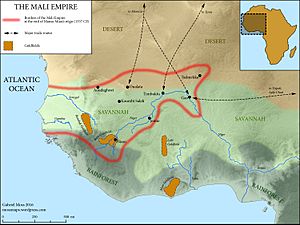
After the fall of Ghana, Soumaoro Kante of Sosso forced Ghana to accept his rule. He also conquered other kingdoms and subdued the Mandinka clans of Manden, where the Bure goldfield was located. According to the traditional Epic of Sundiata, Sundiata Keita, a prince in exile, returned to Manden. He allied with other Mandinka clans and defeated Soumaoro Kante in 1235, proclaiming the start of the Mali Empire.
Allied kingdoms kept their leaders, while conquered ones were given a "farin" (subordinate ruler) under the "mansa" (king/emperor). Provinces kept a lot of freedom. The Malian military expanded west to the Atlantic coast, conquering the Wolof and Serer people. Sundiata died in 1255, and his son, Uli I, conquered more trading centers, strengthening Mali's control over trans-Saharan trade.
After a civil war, Mansa Sakura took power and conquered Gao and subdued the Tuareg people, cementing Mali's dominance. In 1312, Mansa Musa became ruler. He is famous for his pilgrimage (hajj) to Mecca between 1324 and 1325. His huge entourage of 60,000 men, including 12,000 slaves, and hundreds of camels carrying about 18 tons of gold, traveled 2,700 miles. He gave gifts to the poor and built good relations with the Mamluk sultan, gaining widespread attention in the Muslim world.
When Musa returned, his general reasserted control over Gao. Musa also started a large building program, constructing mosques and schools. Timbuktu became a center for trade and Islamic learning. Mali's economy was based on farming, animal herding, and crafts, and they traded with many other groups.
In the 14th century, the Jolof Empire and Serer kingdoms broke away from Mali. After Mansa Musa II died in 1387, conflicts within the Keita dynasty weakened Mali's central authority. The Tuareg tribal groups in the Sahara rebelled and captured key trading cities like Timbuktu and Gao, taking over Mali's dominance in trans-Saharan trade.
In the 15th century, the Portuguese and Spanish set up trading posts along the Atlantic coast, establishing commercial relations with Mali. The Songhai, ruled by the Sonni dynasty, expanded and conquered Mema from Mali, fighting over the crumbling empire.
Colonial Period (1870–1951)
The Scramble for Africa
Between 1878 and 1898, European countries divided and conquered most of Africa. For 400 years, Europeans had mostly stayed on the African coast, with few venturing inland. The Industrial Revolution in Europe brought new technologies that helped them overcome this. These included repeating rifles, which were faster to load than older muskets, and the maxim gun, an early machine gun. European states kept these powerful weapons for themselves, refusing to sell them to African leaders.
African diseases also made it hard for Europeans to settle permanently. Diseases like yellow fever, sleeping sickness, and malaria were common and deadly for Europeans. However, in 1854, the discovery of quinine and other medical advances made conquest and colonization in Africa possible.
There were strong reasons for conquering Africa. European factories needed raw materials. There was also a desire for prestige and competition among European empires. Acquiring African colonies showed that a nation was powerful. These factors led to the "Scramble for Africa."
By the 1880s, European powers had taken almost all of Africa, with only Ethiopia and Liberia remaining independent. Europeans often used ideas like "civilizing missions" to justify their actions, claiming they were bringing progress to Africa. Imperialism ruled until after World War II, when African nationalism grew stronger.
In the 1950s and 1960s, colonial holdings became independent states. This process was usually peaceful, but some countries, like Algeria and Kenya, had long, bloody civil wars. Across Africa, the new force of nationalism grew, partly because many Africans had learned advanced military skills serving in European armies during the world wars. Nationalist organizations began to challenge both the colonial powers and the traditional local leaders who had worked with the colonizers. These nationalist leaders took control when the Europeans left.
Postcolonial Africa (1951 – Present)
The wave of decolonization in Africa began with Libya in 1951. Liberia, South Africa, Egypt, and Ethiopia were already independent. Many other countries gained independence in the 1950s and 1960s. The year 1960 was especially important, known as the "Year of Africa," when 17 African nations declared independence.
Most remaining countries gained independence throughout the 1960s. However, some colonizers, especially Portugal, were slow to give up control, leading to long wars of independence. The last African countries to gain formal independence were Guinea-Bissau (1974), Mozambique (1975), and Angola (1975) from Portugal; Djibouti from France in 1977; Zimbabwe from the United Kingdom in 1980; and Namibia from South Africa in 1990. Eritrea later separated from Ethiopia in 1993.
The newly independent countries decided to keep their colonial borders at the Organisation of African Unity (OAU) conference in 1964. This was to avoid civil wars and instability. They also focused on Pan-Africanism, a movement to unite all Africans. The OAU later became the African Union. In the 1990s and early 2000s, there were the First and Second Congo Wars, sometimes called the African World Wars, which involved many countries.
How We Study African History Today
Colonial Views of History
The way history is studied, called historiography, changed when Europeans arrived in Africa. Before colonization in the 19th century, most African societies used oral traditions to record their history, even if they had writing systems. This meant there wasn't much written history. Because European powers dominated the continent, African history was often written only from a European point of view, which sometimes showed a belief in Western superiority.
This lack of written history and unfamiliar ways of recording it led some Europeans to think that Africa had no recorded history or desire to create it. Historical works from that time were mostly written by European scholars and focused on individual nations, leading to differences in style and quality.
Postcolonial Views of History
Post-colonialist history studies how European colonialism affected the way African history was created and presented. It has roots in the idea of Orientalism, which describes how Western cultures sometimes created a simplified or biased view of Asian, Arabian, and North African cultures, based on a sense of Western superiority. Post-colonial historians try to analyze and criticize these colonial historical works. Important general histories of Africa include The Cambridge History of Africa and the General History of Africa published by UNESCO.
Modern Ways of Studying History
Today, there's a greater understanding and acceptance of African nations and people as unique individuals. This has allowed African history to be studied from new perspectives and with new methods. Africa has many different cultures and communities, so a single approach to history can't capture everything.
The large amount and variety of history that still needs to be documented is better suited to modern historical studies that include social sciences like anthropology, sociology, and geography. These fields look more closely at the human side of history rather than just focusing on political events. There have also been big steps forward in studying oral traditions.
See also
 In Spanish: Historia de África para niños
In Spanish: Historia de África para niños
- Architecture of Africa
- History of science and technology in Africa
- Military history of Africa
- Genetic history of Africa
- Economic history of Africa
- African historiography
- List of history journals#Africa
- List of kingdoms in Africa throughout history
- List of sovereign states and dependent territories in Africa
Images for kids


